Determination of Time Domain Reflectometry Surface Sensors Sensitivity Depending on Geometry and Material Moisture
Abstract
:1. Introduction
2. Materials and Methods
2.1. Description of the Surface TDR Sensors Design
2.2. Description of the Tested Material and Sample Preparation
2.3. Description of the Experimental Setup
- TDR multimeter with multiplexer (LOM, ETest, Lublin, Poland);
- Surface TDR sensors—Sensor A and Sensor B (own design);
- PC for TDR meter control and data processing;
- Software to control the TDR meter and post-process the obtained data (own design);
- Two sets of aerated concrete samples;
- Laboratory scales (WPT 6 C/1, Radwag, Poland);
- Drying oven (Memmert VO-500).
2.4. Description of Analysis Methods
3. Results
4. Discussion
- Equality of the group averages for the main factor—moisture;
- Equality of the group averages for the main factor—thickness;
- Equality of the group averages for the interaction of moisture and thickness.
- The main effect of moisture is statistically significant and large (F(6, 140) = 1498.23, p < 0.001; = 0.98, 90% CI (0.98, 0.99));
- The main effect of thickness is statistically significant and large (F(9, 140) = 63.77, p < 0.001; = 0.80, 90% CI (0.76, 0.84));
- The interaction between moisture and thickness is statistically significant and large (F(54, 140) = 6.05, p < 0.001; = 0.70, 90% CI (0.58, 0.72)).
- The main effect of moisture is statistically significant and large (F(6, 140) = 3196.57, p < 0.001; = 0.99, 90% CI (0.99, 0.99));
- The main effect of thickness is statistically significant and large (F(9, 140) = 241.16, p < 0.001; = 0.94, 90% CI (0.93, 0.95));
- The interaction between moisture and thickness is statistically significant and large (F(54, 140) = 18.71, p < 0.001; = 0.88, 90% CI (0.84, 0.89)).
5. Conclusions
- The range of both sensors influence does not exceed 50 mm deep into the examined material.
- The space between measuring rods of the TDR sensor influences the range of sensor influence. In the case of the narrow sensor A, with the span between two rods equal 30 mm, its range is approximately 30 mm. In the case of the wider design with a rod spacing of 70 mm, its range of effect reaches 50 mm.
- Material moisture influences the range of the sensitivity of the tested sensors.
- Estimation of signal influence in the case of dry or low-moisture material was not possible; only one homogenous group was distinguished in post hoc tests.
- In the case of the medium-saturated material, it was possible to distinguish two homogenous groups, and the sensor sensitivity reached between 10 and 20 mm.
- In the case of highly saturated samples, the sensor sensitivity range was the deepest.
- The achieved values should be treated as technical data and used for proper calibration procedures as well as proper conduct of laboratory and in situ measurements.
Author Contributions
Funding
Institutional Review Board Statement
Informed Consent Statement
Data Availability Statement
Conflicts of Interest
References
- Quinones, H.; Ruelle, P. Operative Calibration Methodology of a TDR Sensor for Soil Moisture Monitoring under Irrigated Crops. Subsurf. Sens. Technol. Appl. 2001, 2, 31–45. [Google Scholar] [CrossRef]
- Udawatta, R.P.; Anderson, S.H.; Motavalli, P.P.; Garrett, H.E. Calibration of a Water Content Reflectometer and Soil Water Dynamics for an Agroforestry Practice. Agroforest. Syst. 2011, 82, 61–75. [Google Scholar] [CrossRef]
- Soncela, R.; Sampaio, S.C.; Vilas Boas, M.A.; Tavares, M.H.F.; Smanhotto, A. Construction and Calibration of TDR Probes for Volumetric Water Content Estimation in a Distroferric Red Latosol. Eng. Agríc. 2013, 33, 919–928. [Google Scholar] [CrossRef] [Green Version]
- Dwevedi, A.; Kumar, P.; Kumar, P.; Kumar, Y.; Sharma, Y.K.; Kayastha, A.M. Soil Sensors: Detailed Insight into Research Updates, Significance, and Future Prospects. In New Pesticides and Soil Sensors; Elsevier: Amsterdam, The Netherlands, 2017; pp. 561–594. ISBN 978-0-12-804299-1. [Google Scholar]
- Topp, G.C.; Davis, J.L.; Annan, A.P. Electromagnetic Determination of Soil Water Content: Measurements in Coaxial Transmission Lines. Water Resour. Res. 1980, 16, 574–582. [Google Scholar] [CrossRef] [Green Version]
- Malicki, M.A.; Plagge, R.; Roth, C.H. Improving the Calibration of Dielectric TDR Soil Moisture Determination Taking into Account the Solid Soil. Eur. J. Soil. Sci. 1996, 47, 357–366. [Google Scholar] [CrossRef]
- Černý, R. Time-Domain Reflectometry Method and Its Application for Measuring Moisture Content in Porous Materials: A Review. Measurement 2009, 42, 329–336. [Google Scholar] [CrossRef]
- Barnat-Hunek, D.; Smarzewski, P.; Suchorab, Z. Effect of Hydrophobisation on Durability Related Properties of Ceramic Brick. Constr. Build. Mater. 2016, 111, 275–285. [Google Scholar] [CrossRef]
- Suchorab, Z.; Majerek, D.; Kočí, V.; Černý, R. Time Domain Reflectometry Flat Sensor for Non-Invasive Monitoring of Moisture Changes in Building Materials. Measurement 2020, 165, 108091. [Google Scholar] [CrossRef]
- Freitas, T.S.; Guimarães, A.S.; Roels, S.; Peixoto de Freitas, V.; Cataldo, A. Is the Time-Domain Reflectometry (TDR) Technique Suitable for Moisture Content Measurement in Low-Porosity Building Materials? Sustainability 2020, 12, 7855. [Google Scholar] [CrossRef]
- Hilhorst, M.A.; Dirksen, C. Dielectric Water Content Sensors: Time Domain versus Frequency Domain. In Time Domain Reflectometry in Environmental, Infrastructure, and Mining Applications; US Department Interior Bureau of Mines, Northwestern University: Evanston, IL, USA, 1994; pp. 23–33. [Google Scholar]
- Robert, A. Dielectric Permittivity of Concrete between 50 Mhz and 1 Ghz and GPR Measurements for Building Materials Evaluation. J. Appl. Geophys. 1998, 40, 89–94. [Google Scholar] [CrossRef]
- Oliveira, J.G.D.; Junior, J.G.D.; Pinto, E.N.M.G.; Neto, V.P.S.; D’Assunção, A.G. A New Planar Microwave Sensor for Building Materials Complex Permittivity Characterization. Sensors 2020, 20, 6328. [Google Scholar] [CrossRef]
- Topp, G.C.; Zebchuk, W.D.; Davis, J.L.; Bailey, W.G. The measurement of soil water content using a portable tdr hand probe. Can. J. Soil. Sci. 1984, 64, 313–321. [Google Scholar] [CrossRef]
- Malicki, M.A.; Plagge, R.; Renger, M.; Walczak, R.T. Application of Time-Domain Reflectometry (TDR) Soil Moisture Miniprobe for the Determination of Unsaturated Soil Water Characteristics from Undisturbed Soil Cores. Irrig. Sci 1992, 13, 65–72. [Google Scholar] [CrossRef]
- Ren, T.; Noborio, K.; Horton, R. Measuring Soil Water Content, Electrical Conductivity, and Thermal Properties with a Thermo-Time Domain Reflectometry Probe. Soil Sci. Soc. Am. J. 1999, 63, 450–457. [Google Scholar] [CrossRef]
- Knight, J.H. Sensitivity of Time Domain Reflectometry Measurements to Lateral Variations in Soil Water Content. Water Resour. Res. 1992, 28, 2345–2352. [Google Scholar] [CrossRef]
- Suchorab, Z.; Widomski, M.; Łagód, G.; Barnat-Hunek, D.; Majerek, D. A Noninvasive TDR Sensor to Measure the Moisture Content of Rigid Porous Materials. Sensors 2018, 18, 3935. [Google Scholar] [CrossRef] [PubMed] [Green Version]
- Noborio, K. Measurement of Soil Water Content and Electrical Conductivity by Time Domain Reflectometry: A Review. Comput. Electron. Agric. 2001, 31, 213–237. [Google Scholar] [CrossRef]
- Noborio, K.; Horton, R.; Tan, C.S. Time Domain Reflectometry Probe for Simultaneous Measurement of Soil Matric Potential and Water Content. Soil Sci. Soc. Am. J. 1999, 63, 1500–1505. [Google Scholar] [CrossRef]
- Blonquist, J.M., Jr.; Jones, S.B.; Robinson, D.A. A Time Domain Transmission Sensor with TDR Performance Characteristics. J. Hydrol. 2005, 314, 235–245. [Google Scholar] [CrossRef]
- Zegelin, S.J.; White, I.; Jenkins, D.R. Improved Field Probes for Soil Water Content and Electrical Conductivity Measurement Using Time Domain Reflectometry. Water Resour. Res. 1989, 25, 2367–2376. [Google Scholar] [CrossRef]
- He, H.; Aogu, K.; Li, M.; Xu, J.; Sheng, W.; Jones, S.B.; González-Teruel, J.D.; Robinson, D.A.; Horton, R.; Bristow, K.; et al. A Review of Time Domain Reflectometry (TDR) Applications in Porous Media. In Advances in Agronomy; Elsevier: Amsterdam, The Netherlands, 2021; Volume 168, pp. 83–155. ISBN 978-0-12-824589-7. [Google Scholar]
- Majcher, J.; Kafarski, M.; Wilczek, A.; Szypłowska, A.; Lewandowski, A.; Woszczyk, A.; Skierucha, W. Application of a Dagger Probe for Soil Dielectric Permittivity Measurement by TDR. Measurement 2021, 178, 109368. [Google Scholar] [CrossRef]
- Hudson, D.B.; Wierenga, P.J.; Hills, R.G. Unsaturated Hydraulic Properties from Upward Flow into Soil Cores. Soil Sci. Soc. Am. J. 1996, 60, 388–396. [Google Scholar] [CrossRef]
- Dalton, F.N. Development of Time-Domain Reflectometry for Measuring Soil Water Content and Bulk Soil Electrical Conductivity. In SSSA Special Publications; Clarke Topp, G., Daniel Reynolds, W., Green, R.E., Eds.; Soil Science Society of America: Madison, WI, USA, 2012; pp. 143–167. ISBN 978-0-89118-925-1. [Google Scholar]
- Zegelin, S.J.; White, I.; Russell, G.F. A Critique of the Time Domain Reflectometry Technique for Determining Field Soil-Water Content. In SSSA Special Publications; Clarke Topp, G., Daniel Reynolds, W., Green, R.E., Eds.; Soil Science Society of America: Madison, WI, USA, 2012; pp. 187–208. ISBN 978-0-89118-925-1. [Google Scholar]
- Chabriac, P.-A.; Fabbri, A.; Morel, J.-C.; Laurent, J.-P.; Blanc-Gonnet, J. A Procedure to Measure the In-Situ Hygrothermal Behavior of Earth Walls. Materials 2014, 7, 3002–3020. [Google Scholar] [CrossRef] [PubMed] [Green Version]
- Brzyski, P.; Suchorab, Z. Capillary Uptake Monitoring in Lime-Hemp-Perlite Composite Using the Time Domain Reflectometry Sensing Technique for Moisture Detection in Building Composites. Materials 2020, 13, 1677. [Google Scholar] [CrossRef] [PubMed] [Green Version]
- Pavlik, Z.; Fiala, L.; Cerny, R. Determination of Moisture Content of Hygroscopic Building Materials Using Time Domain Reflectometry. J. Appl. Sci. 2008, 8, 1732–1737. [Google Scholar] [CrossRef] [Green Version]
- de Place Hansen, E.J.; Hansen, M.H. TDR Measurement of Moisture Content in Aerated Concrete. In Proceedings of the 6th Symposium on Building Physics in the Nordic Countries, Trondheim, Norway, 17–19 June 2002; pp. 381–388. [Google Scholar]
- Pavlík, Z.; Jiřičková, M.; Černý, R.; Sobczuk, H.; Suchorab, Z. Determination of Moisture Diffusivity Using the Time Domain Reflectometry (TDR) Method. J. Build. Phys. 2006, 30, 59–70. [Google Scholar] [CrossRef]
- Selker, J.S.; Graff, L.; Steenhuis, T. Noninvasive Time Domain Reflectometry Moisture Measurement Probe. Soil Sci. Soc. Am. J. 1993, 57, 934–936. [Google Scholar] [CrossRef]
- Persson, M.; Berndtsson, R. Noninvasive Water Content and Electrical Conductivity Laboratory Measurements Using Time Domain Reflectometry. Soil Sci. Soc. Am. J. 1998, 62, 1471–1476. [Google Scholar] [CrossRef]
- Wraith, J.M.; Robinson, D.A.; Jones, S.B.; Long, D.S. Spatially Characterizing Apparent Electrical Conductivity and Water Content of Surface Soils with Time Domain Reflectometry. Comput. Electron. Agric. 2005, 46, 239–261. [Google Scholar] [CrossRef]
- Sobczuk, H. Sonda Do Pomiaru Wilgotności Ośrodków Porowatych, Zwłaszcza Materiałów Budowlanych. Polish Patent 198492, 30 June 2008. (In Polish). [Google Scholar]
- Sobczuk, H.; Plagge, R. Time Domain Reflectometry Method in Environmental Measurements; Polska Akademia Nauk. Komitet Inżynierii Środowiska: Lublin, Poland, 2007; Volume 39. [Google Scholar]
- Ferré, P.A.; Knight, J.H.; Rudolph, D.L.; Kachanoski, R.G. The Sample Areas of Conventional and Alternative Time Domain Reflectometry Probes. Water Resour. Res. 1998, 34, 2971–2979. [Google Scholar] [CrossRef]
- Robinson, D.A. Parallel Plates Compared with Conventional Rods as TDR Waveguides for Sensing Soil Moisture. Subsurf. Sens. Technol. Appl. 2000, 1, 497–511. [Google Scholar] [CrossRef]
- Qin, P.-J.; Liu, Z.-R.; Lai, X.-L.; Wang, Y.-B.; Song, Z.-W.; Miao, C.-X. A New Method to Determine the Spatial Sensitivity of Time Domain Reflectometry Probes Based on Three-Dimensional Weighting Theory. Water 2020, 12, 545. [Google Scholar] [CrossRef] [Green Version]
- E-Test Ltd. Manual FOM/Mts and TDR/MUX/Mpts and TDR/MUX/Mpts/Dlog Ver. 1.41. Available online: https://www.e-Test.Eu/Uploads/5/4/4/3/54435037/Manual_fommts_tdrmuxmpts_v1.41.Pdf (accessed on 14 January 2022).
- Ferré, P.A.; Knight, J.H.; Rudolph, D.L.; Kachanoski, R.G. A Numerically Based Analysis of the Sensitivity of Conventional and Alternative Time Domain Reflectometry Probes. Water Resour. Res. 2000, 36, 2461–2468. [Google Scholar] [CrossRef]
- Fujikoshi, Y. Two-Way ANOVA Models with Unbalanced Data. Discret. Math. 1993, 116, 315–334. [Google Scholar] [CrossRef] [Green Version]
- Salahuddin; Khola, R.K. Analysis of Chloride Content in the Surface of Water Using Two Way Anova. Int. J. Pharm. Res. Sch. 2013, 2, 51–53. [Google Scholar]
- Skierucha, W.; Wilczek, A.; Alokhina, O. Calibration of a TDR Probe for Low Soil Water Content Measurements. Sens. Actuators A Phys. 2008, 147, 544–552. [Google Scholar] [CrossRef]
- BSI. EN 772-13: 2000, Methods of Test for Masonry Units—Part 13: Determination of Net and Gross Dry Density of Masonry Units (Except for Natural Stone); BSI: London, UK, 2000. [Google Scholar]
- Fisher, R.A. Statistical Methods for Research Workers, 6th ed.; Oliver and Boyd: Edinburgh, Scotland, 1925. [Google Scholar]
- Yates, F. The Analysis of Multiple Classifications with Unequal Numbers in the Different Classes. J. Am. Stat. Assoc. 1934, 29, 51–66. [Google Scholar] [CrossRef]
- Gelman, A. Analysis of Variance—Why It Is More Important than Ever. Ann. Stat. 2005, 33, 1–53. [Google Scholar] [CrossRef] [Green Version]
- Lin, J.-W.; Szu, Y.-C.; Lai, C.-N. Effects of Group Awareness and Self-Regulation Level on Online Learning Behaviors. IRRODL 2016, 17, 224–241. [Google Scholar] [CrossRef] [Green Version]
- Al-Sanafi, M.; Sallam, M. Psychological Determinants of COVID-19 Vaccine Acceptance among Healthcare Workers in Kuwait: A Cross-Sectional Study Using the 5C and Vaccine Conspiracy Beliefs Scales. Vaccines 2021, 9, 701. [Google Scholar] [CrossRef]
- Choi, Y.; Lee, K.; Chang, H.-S. Comparison of Polymerization Shrinkage of Dual-Cure Core Build-up Resin According to Shade and Curing Mode. Oral. Biol. Res. 2019, 43, 243–249. [Google Scholar] [CrossRef] [Green Version]
- Field, A. Discovering Statistics Using IBM SPSS Statistics, 4th ed.; SAGE: London, UK, 2013. [Google Scholar]
- R Core Team. R: A Language and Environment for Statistical Computing; R Core Team: Vienna, Austria, 2016. [Google Scholar]
- de Mendiburu, F. Statistical Procedures for Agricultural Research. 2021. Available online: https://cran.r-project.org/web/packages/agricolae/agricolae.pdf (accessed on 14 January 2022).
- Ben-Shachar, M.S. Indices of Effect Size and Standardized Parameters. 2022. Available online: https://cran.r-project.org/web/packages/effectsize/effectsize.pdf (accessed on 14 January 2022).
- Wickham, H.; Chang, W.; Henry, L.; Pedersen, T.L.; Takahashi, K.; Wilke, C.; Woo, K.; Yutani, H.; Dunnington, D. RStudio. Ggplot2: Create Elegant Data Visualisations Using the Grammar of Graphics. 2018. Available online: https://rdrr.io/cran/ggplot2/ (accessed on 14 January 2022).
- Kassambara, A. Rstatix: Pipe-Friendly Framework for Basic Statistical Tests. 2020. Available online: https://cran.r-project.org/web/packages/rstatix/index.html (accessed on 14 January 2022).
- Lindman, H.R. Analysis of Variance in Complex Experimental Design; W.H.Freeman & Co., Ltd.: New York, NY, USA, 1975. [Google Scholar]
- Mohamed, A.M.O. Principles and Applications of Time Domain Electrometry in Geoenvi-Ronmental Engineering; CRC Press: Boca Raton, FL, USA, 2006. [Google Scholar]

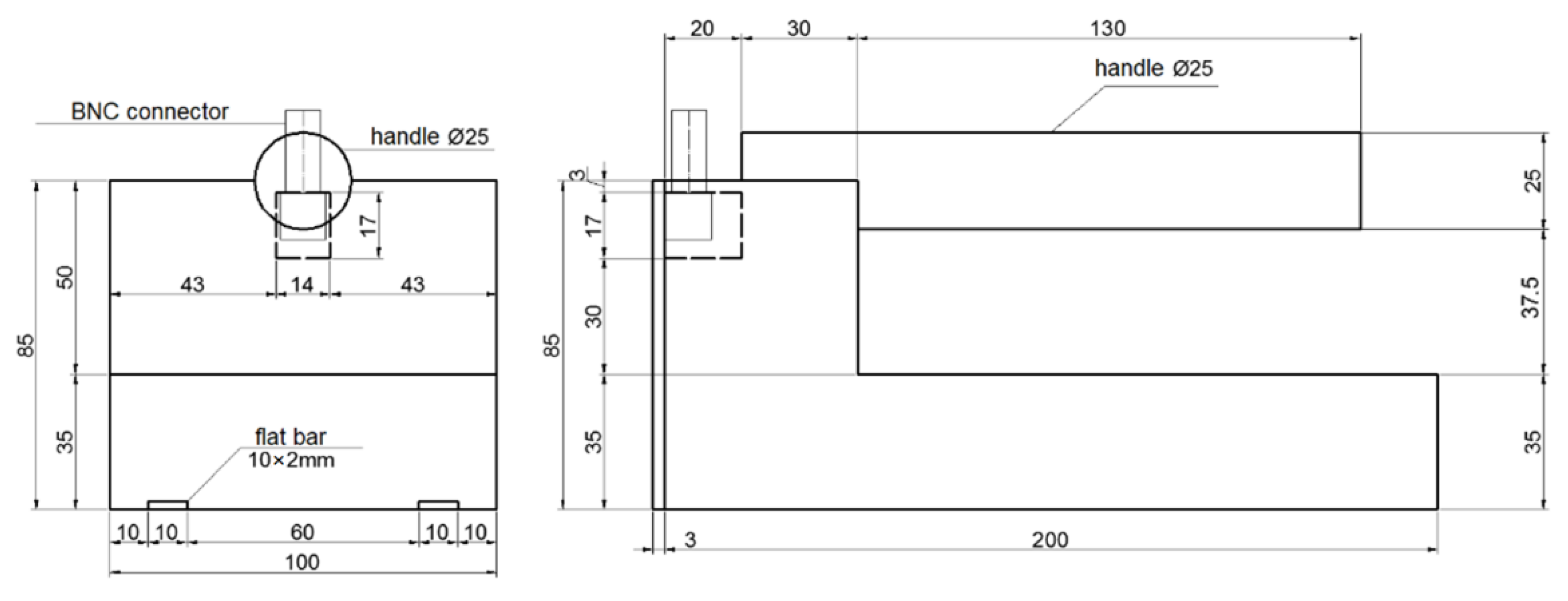

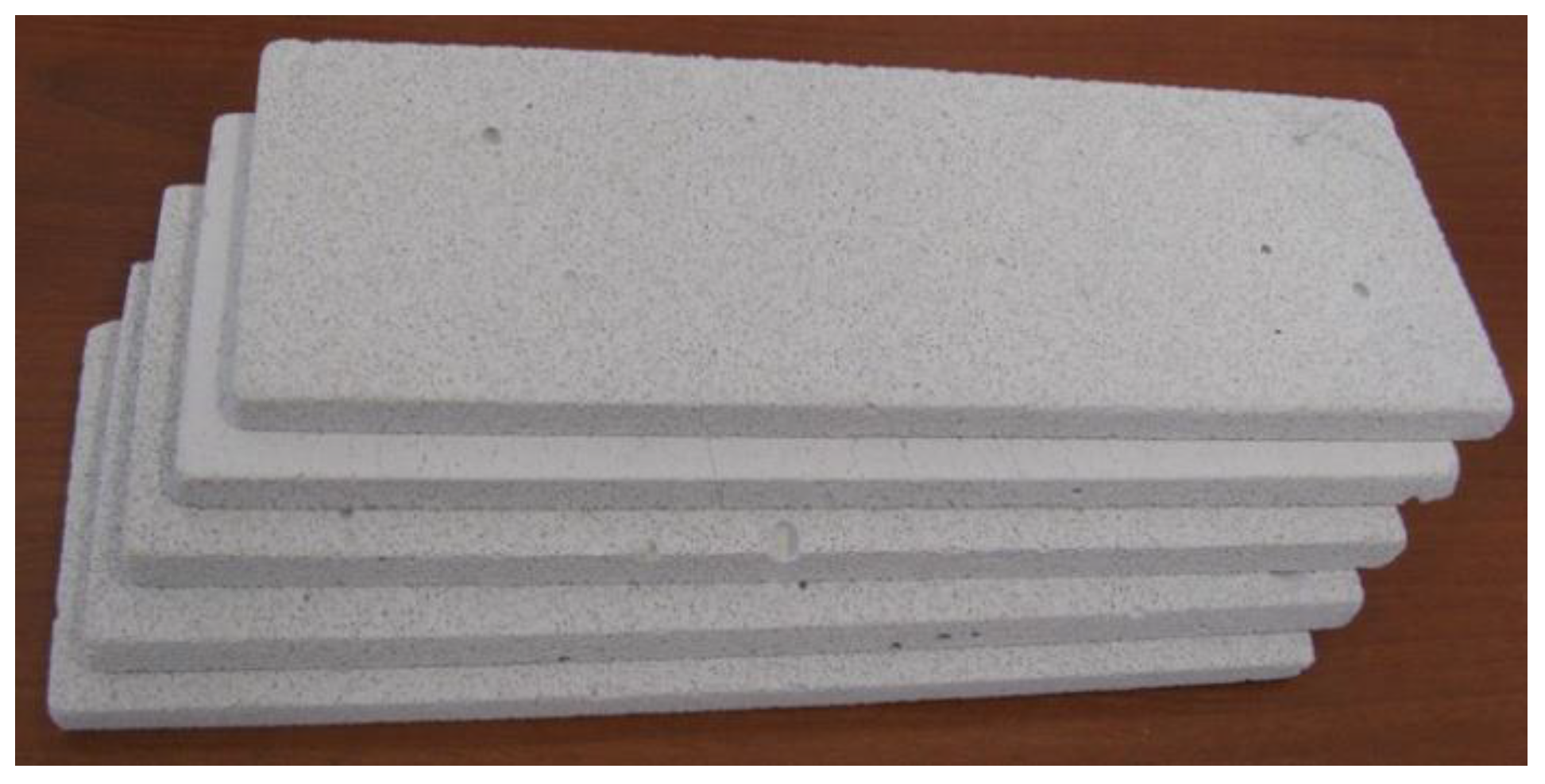

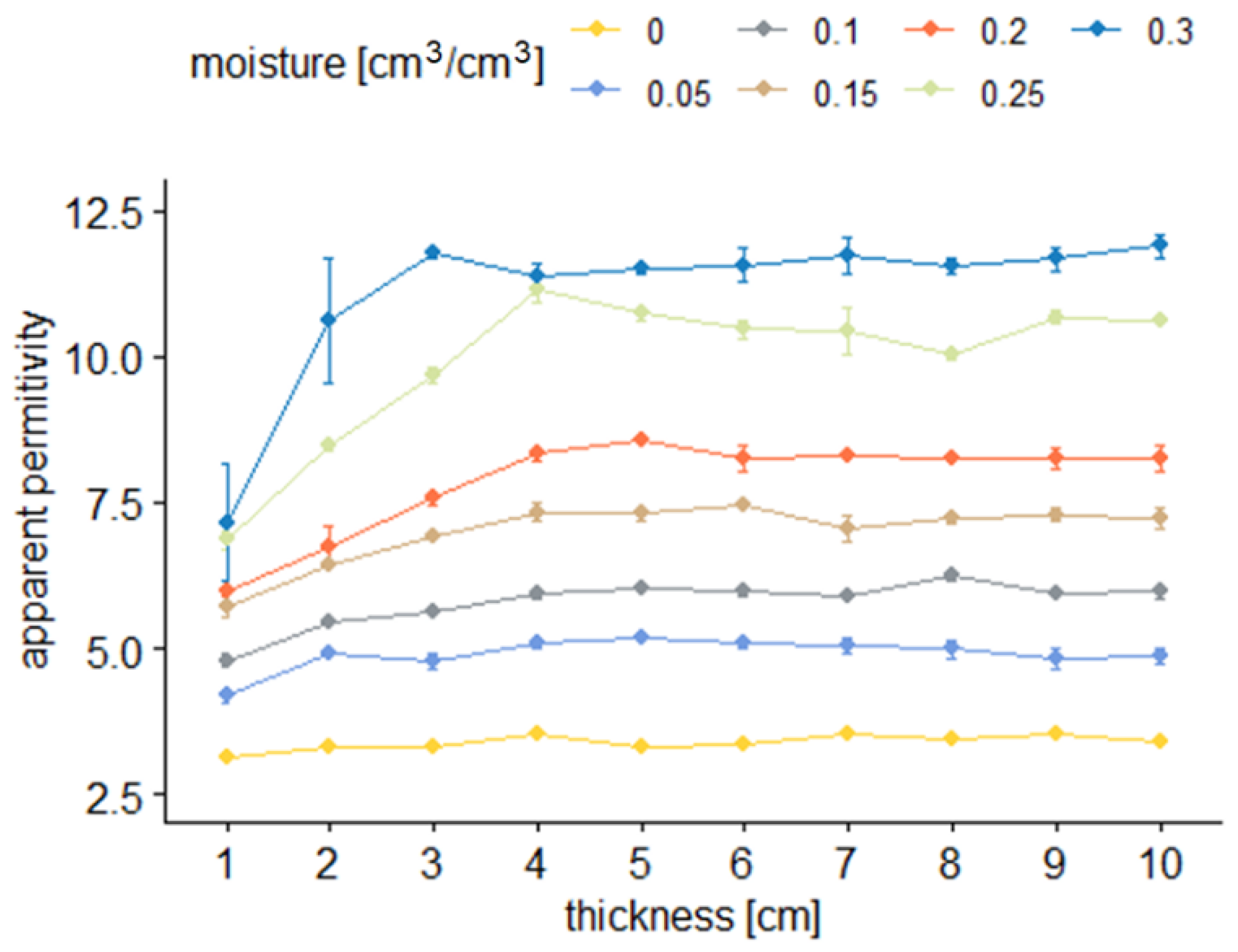
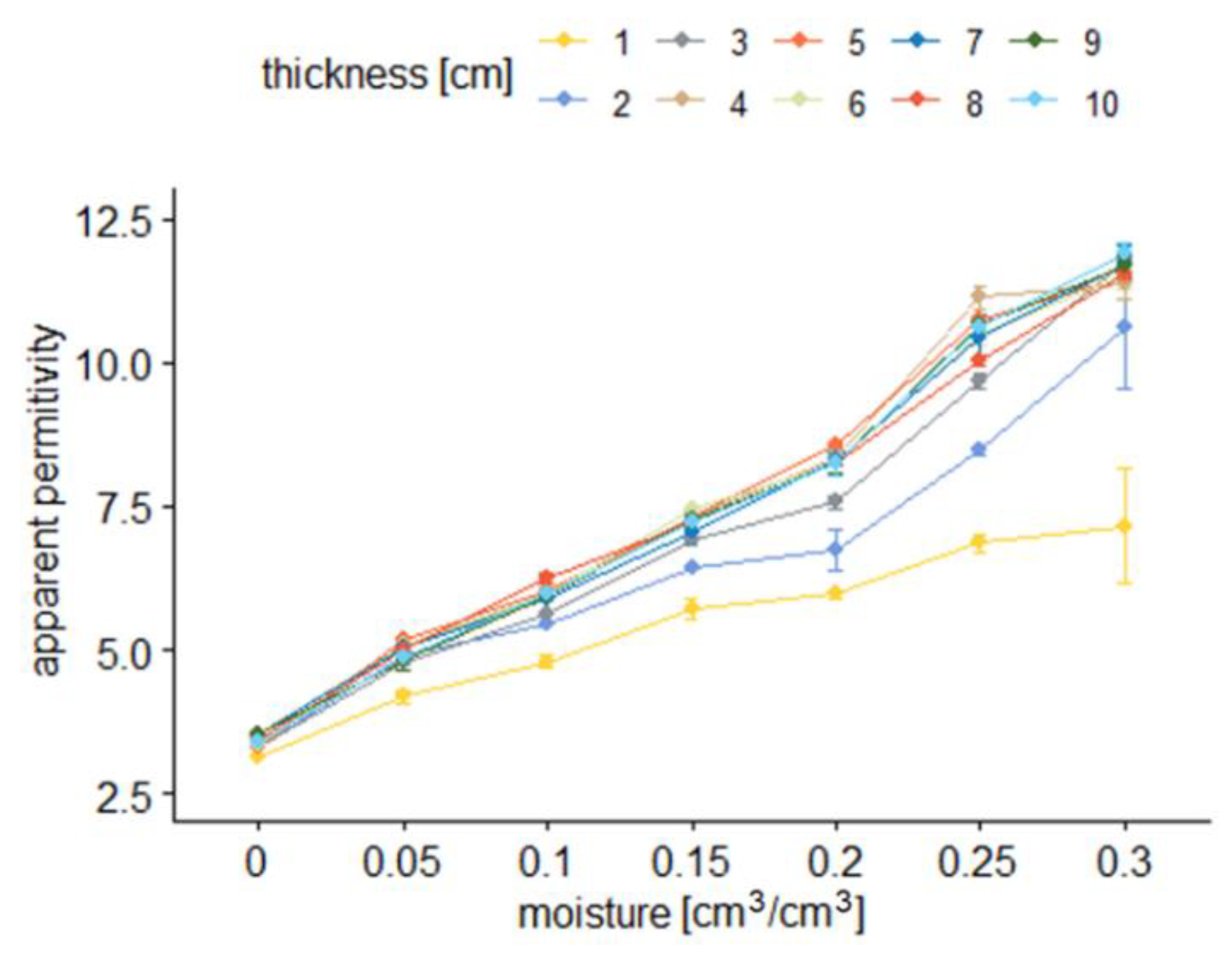
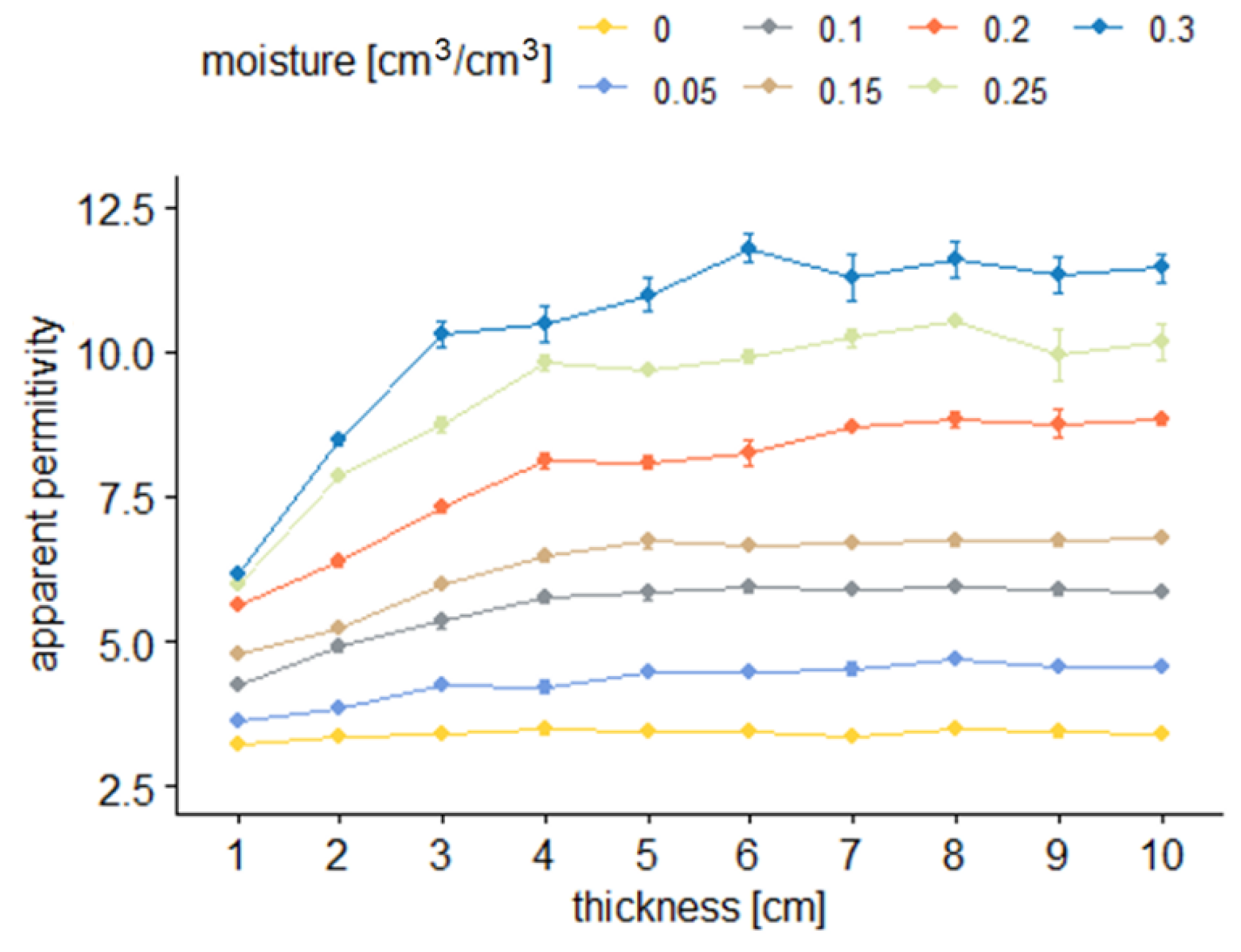
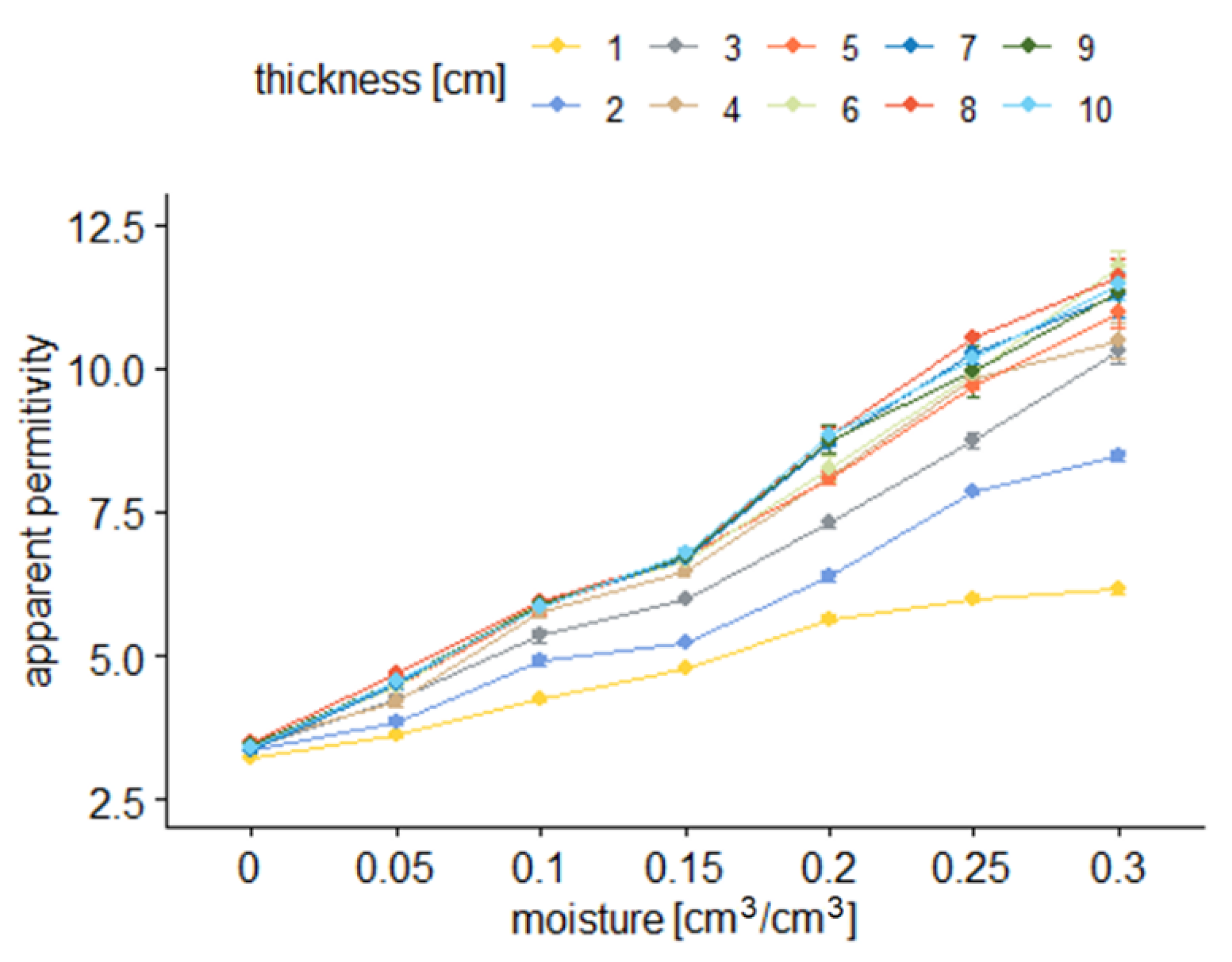
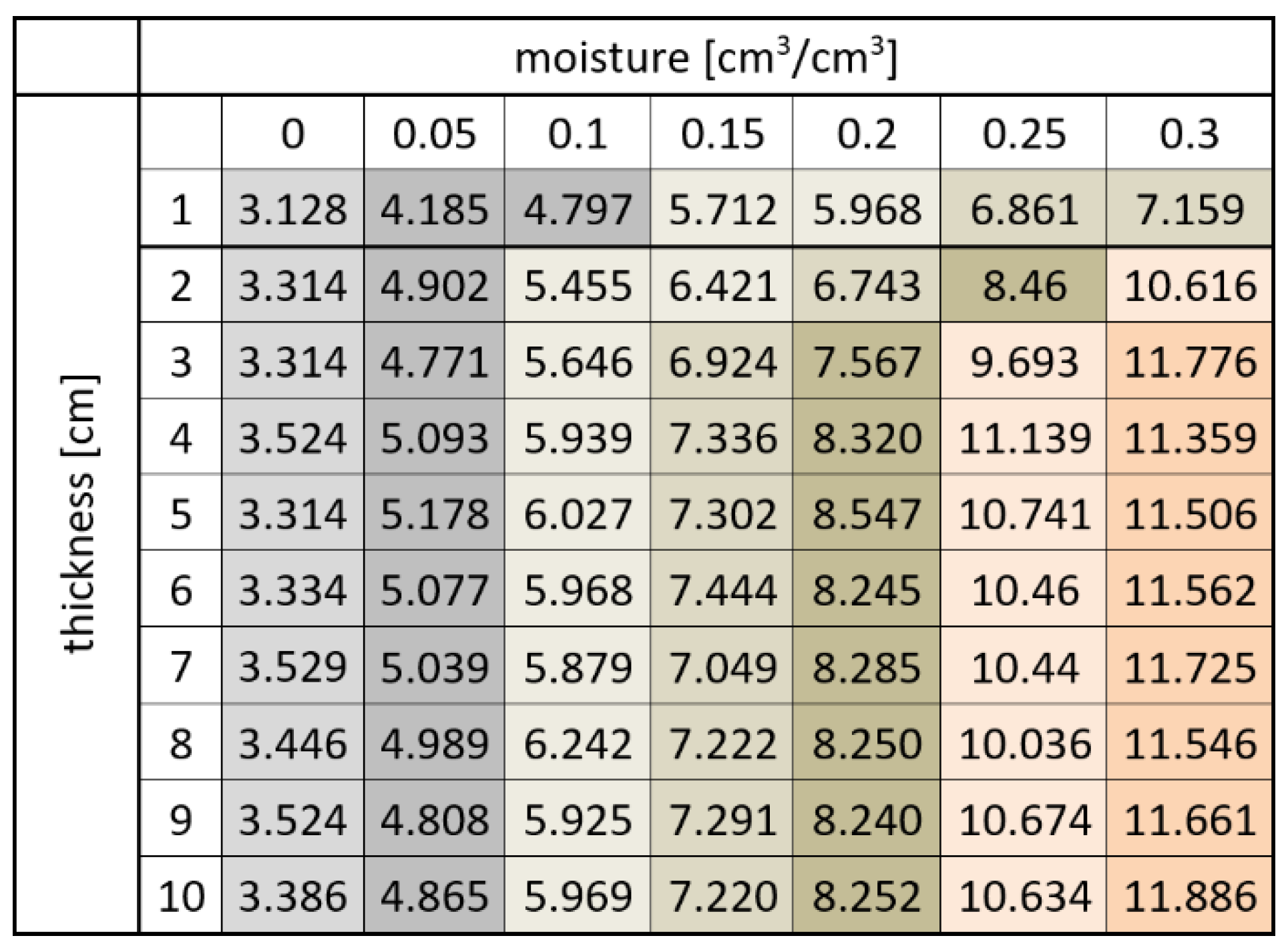
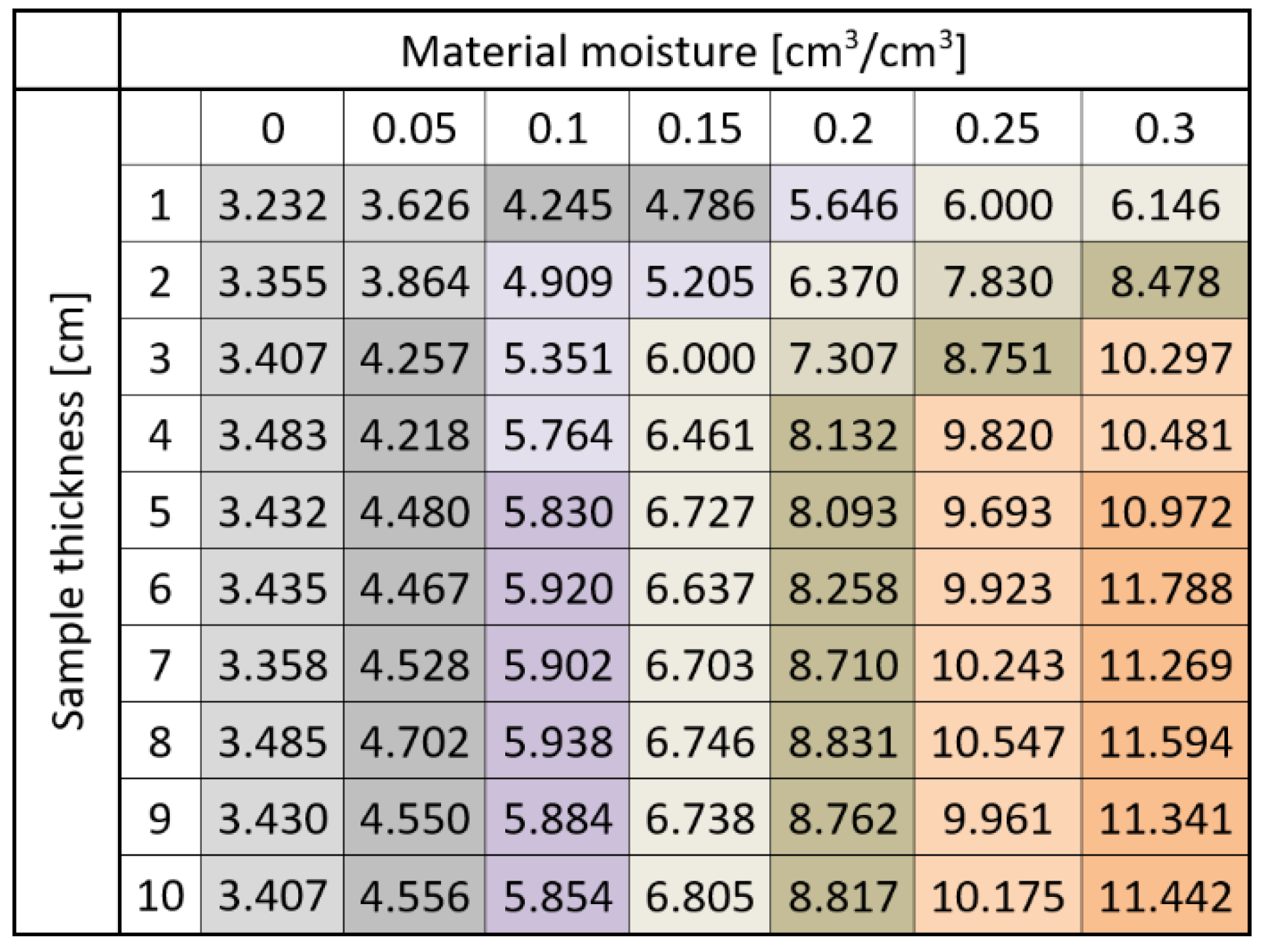
| Parameter | Unit | Value |
|---|---|---|
| Bulk density | (kg/m3) | 620 |
| Maximum volumetric water absorptivity | (cm3/cm3) | 0.3 |
| Moisture (cm3/cm3) | Regression Model | R2 |
|---|---|---|
| 0 | ε = 0.0272 d + 3.232 | 0.403 |
| 0.05 | ε = −0.0282 d2 + 0.3488 d + 4.0597 | 0.548 |
| 0.1 | ε = −0.0302 d2 + 0.4326 d + 4.5677 | 0.821 |
| 0.15 | ε = −0.0427 d2 + 0.5933 d + 5.3722 | 0.756 |
| 0.2 | ε = −0.0663 d2 + 0.9359 d + 5.2477 | 0.841 |
| 0.25 | ε = −0.0986 d2 + 1.3801 d + 6.1187 | 0.774 |
| 0.3 | ε = −0.0985 d2 + 1.3863 d + 7.2492 | 0.545 |
| Thickness (cm) | Regression Model | R2 |
|---|---|---|
| 1 | ε = 13.299 θ + 3.4066 | 0.835 |
| 2 | ε = 21.648 θ + 3.3116 | 0.882 |
| 3 | ε = 26.535 θ + 3.1183 | 0.970 |
| 4 | ε = 27.127 θ + 3.461 | 0.969 |
| 5 | ε = 27.299 θ + 3.4216 | 0.987 |
| 6 | ε = 26.945 θ + 3.3997 | 0.983 |
| 7 | ε = 26.997 θ + 3.3712 | 0.974 |
| 8 | ε = 26.001 θ + 3.4897 | 0.990 |
| 9 | ε = 27.47 θ + 3.3256 | 0.983 |
| 10 | ε = 28.087 θ + 3.2459 | 0.982 |
| Moisture (cm3/cm3) | Regression Model | R2 |
|---|---|---|
| 0 | ε = 0.0128 d + 3.3317 | 0.143 |
| 0.05 | ε = −0.0192 d2 + 0.3097 d + 3.3596 | 0.894 |
| 0.1 | ε = −0.0421 d2 + 0.6125 d + 3.8097 | 0.925 |
| 0.15 | ε = −0.0464 d2 + 0.7125 d + 4.1503 | 0.938 |
| 0.2 | ε = −0.0569 d2 + 0.9584 d + 4.8132 | 0.943 |
| 0.25 | ε = −0.0959 d2 + 1.4364 d + 5.0859 | 0.907 |
| 0.3 | ε = −0.1251 d2 + 1.8447 d + 5.0501 | 0.891 |
| Thickness (cm) | Regression Model | R2 |
|---|---|---|
| 1 | ε = 10.636 θ + 3.2163 | 0.971 |
| 2 | ε = 17.687 θ + 3.0629 | 0.973 |
| 3 | ε = 22.58 θ + 3.0944 | 0.978 |
| 4 | ε = 24.69 θ + 3.205 | 0.980 |
| 5 | ε = 25.222 θ + 3.2491 | 0.990 |
| 6 | ε = 27.365 θ + 3.0992 | 0.981 |
| 7 | ε = 27.121 θ + 3.1764 | 0.984 |
| 8 | ε = 27.794 θ + 3.237 | 0.984 |
| 9 | ε = 26.738 θ + 3.2272 | 0.979 |
| 10 | ε = 27.36 θ + 3.1896 | 0.987 |
Publisher’s Note: MDPI stays neutral with regard to jurisdictional claims in published maps and institutional affiliations. |
© 2022 by the authors. Licensee MDPI, Basel, Switzerland. This article is an open access article distributed under the terms and conditions of the Creative Commons Attribution (CC BY) license (https://creativecommons.org/licenses/by/4.0/).
Share and Cite
Suchorab, Z.; Malec, A.; Sobczuk, H.; Łagód, G.; Gorgol, I.; Łazuka, E.; Brzyski, P.; Trník, A. Determination of Time Domain Reflectometry Surface Sensors Sensitivity Depending on Geometry and Material Moisture. Sensors 2022, 22, 735. https://doi.org/10.3390/s22030735
Suchorab Z, Malec A, Sobczuk H, Łagód G, Gorgol I, Łazuka E, Brzyski P, Trník A. Determination of Time Domain Reflectometry Surface Sensors Sensitivity Depending on Geometry and Material Moisture. Sensors. 2022; 22(3):735. https://doi.org/10.3390/s22030735
Chicago/Turabian StyleSuchorab, Zbigniew, Agnieszka Malec, Henryk Sobczuk, Grzegorz Łagód, Izolda Gorgol, Ewa Łazuka, Przemysław Brzyski, and Anton Trník. 2022. "Determination of Time Domain Reflectometry Surface Sensors Sensitivity Depending on Geometry and Material Moisture" Sensors 22, no. 3: 735. https://doi.org/10.3390/s22030735
APA StyleSuchorab, Z., Malec, A., Sobczuk, H., Łagód, G., Gorgol, I., Łazuka, E., Brzyski, P., & Trník, A. (2022). Determination of Time Domain Reflectometry Surface Sensors Sensitivity Depending on Geometry and Material Moisture. Sensors, 22(3), 735. https://doi.org/10.3390/s22030735









